Cartoons make us laugh.
Politics, in general, does the opposite.
I’ve seen it time after time when I tell someone what I do for work—nothing wipes a smile off a person’s face faster than admitting you work in politics.
I get it. Politics is dirty. It’s divisive. It’s angry. Maybe you’ve seen it in your own life: on social media, at work, or even in your relationships.
So, if politics is so full of anger, why do political cartoons work so well?
I have a few theories.
Personally, political cartoons are the thing that got me into politics in the first place. As a middle schooler devouring my hometown newspaper, editorial cartoons were a halfway point between the comics I loved and the front pages I didn’t understand. As a high schooler, I read just about every cartoon in every edition of the New Yorker.
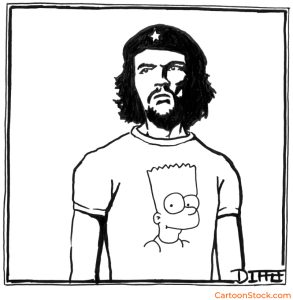
MOST POPULAR NEW YORKER CARTOONS
Then in college, I interned on Capitol Hill, where one of my tasks was compiling the jokes from the previous night’s monologues on the late-night shows. It was eye-opening to see staffers care more about what was said there than in the Washington Post.
There’s power in those jokes.
Later, as an aide in the Wisconsin Legislature, I again saw how much attention was paid to the work of political cartoonists like Phil Hands (Wisconsin State Journal), Stuart Carlson (Milwaukee Journal Sentinel), and Joe Heller (Green Bay Press-Gazette). Once, as communications director for a state Senator, I was furious about my boss’s depiction in one of these cartoons. The senator himself, on the other hand, was thrilled—at being featured by name for the first time.
What gives political cartoons their power?
First, they’re simple. There’s an old saying in politics that if you’re explaining, you’re losing. A single panel is the perfect space for one clear, stinging point, and not much else. It’s the sweet spot of delivering a memorable idea or criticism before the reader’s attention span drifts away.
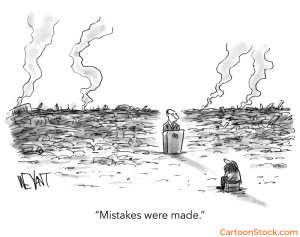
Second, they’re funny. Funny matters in politics. Think about Ronald Reagan’s debate quip about age, or Barack Obama’s takedown of Donald Trump at the 2011 White House Correspondents’ Dinner (arguably the thing that motivated Trump’s 2016 campaign in the first place) or George W. Bush passing the test of “which candidate you’d want to have a beer with.”
Having a sense of humor helps connect at the personal level, and our voting decisions and political identity are among the most personal choices we make. To me, a sense of humor is one of the best “secret weapons” a politician can have, second only to the ability to remember people’s names.
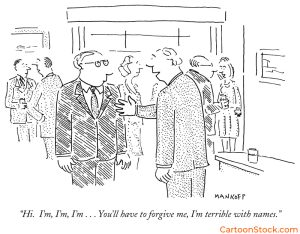
Third, political cartoons stand the test of time. You probably know about the origin of the elephant and donkey symbols, created in Thomas Nast’s cartoons in the 1800s, and Ben Franklin’s famous “Join or Die” snake. Each are hallmarks of both American history and efficient storytelling. The ability to match an idea to a memorable image or metaphor is a skill politicians use in speeches, TV ads, in print, and even in fundraising—because the voters remember them.
At a time when the media landscape is changing fast, political cartoons are still featured in just about every newspaper in the country. Political cartoonists are awarded the Pulitzer Prize; they even had their own category for more than 100 years. And as for the subjects themselves—the candidates and elected officials—they pay close attention to how they’re depicted. Believe me.
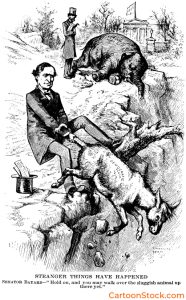
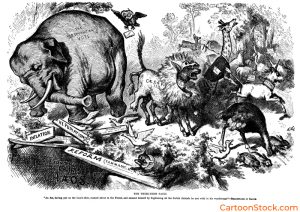
Cartoons work well. But it’s rare that politicians and campaigns use them directly—there’s the timing, the cost, and the difficulty of being funny in the first place. (The political graveyard is full of candidates who thought they were funny, but the voters didn’t.)
But the biggest reason is more cynical.
They aren’t mean enough. Cartoons, by their nature, have a bit of “fun” built in. Two-thirds of political advertising includes a direct attack or contrast. Many campaigns don’t bother with frivolity, especially when they’re behind. Nuance and wit don’t hit hard enough when you need to go for the emotional jugular.
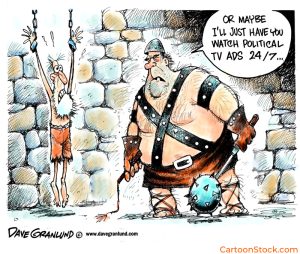
Remember the 2000 presidential campaign? In terms of laughs, I remember the Saturday Night Live sketch about “strategery” and Al Gore’s lockbox the most. But at the time, the big-money closing ads from both campaigns were brutal broadsides, hitting Gore’s trustworthiness and Bush’s values.
When the stakes are highest, anger has a bigger impact than humor. An old boss of mine in Wisconsin summed it up best: The day you stop seeing attack ads is the day they stop working.
But here’s the thing—something I always keep in mind when I see that smile drain away—people still live in the real world.
Every person has their own life, their own motivations, and their own reasons to feel and vote the way they do. I believe that’s a feature—not a bug—of American democracy. Every person’s vote counts the exact same, no matter what brought them to the voting booth.
So, if you aren’t running for office, your tactics can be different.
If you care more about making your friends laugh, or getting someone’s attention with an eye-catching image, or getting your point across in a unique way, a cartoon is a better option than a scorched-earth attack ad.
If you type “politics” into the search bar on CartoonStock today, you’ll find more than 51,000 cartoons available. But here’s the best part—there are more than 500,000 cartoons total…so nearly nine in 10 cartoons on the site are NOT about politics!
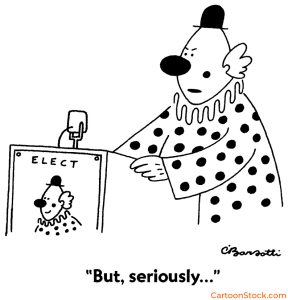
So, if you’re looking to put some humor into the world (instead of hostility), spend a few minutes on CartoonStock. You can use what you find in your presentations, or newsletters, or emails, or even your social media.
After all, it’s hard to disagree with someone when you’re laughing with them.
Andrew Welhouse is a former communications director, senior staff, and ghostwriter for dozens of elected officials and political campaigns. He is currently a Ph.D. candidate at the University of Utah and senior writer for the Foundation for Government Accountability. Most importantly, he is a two-time winner of the CartoonStock Caption Contest.

